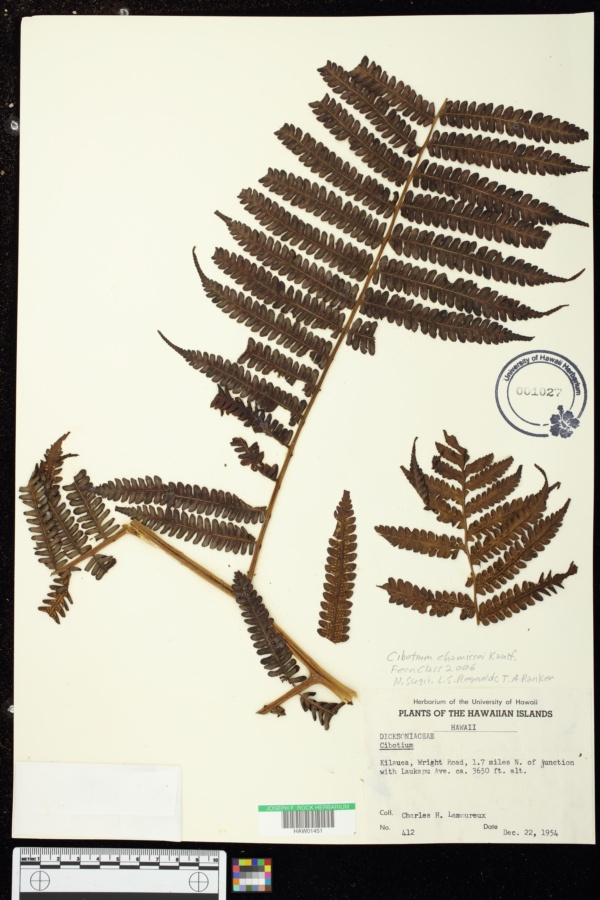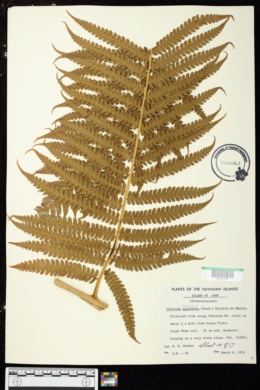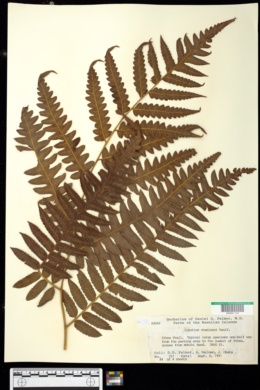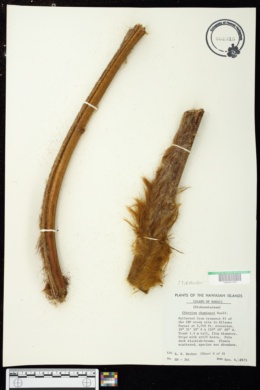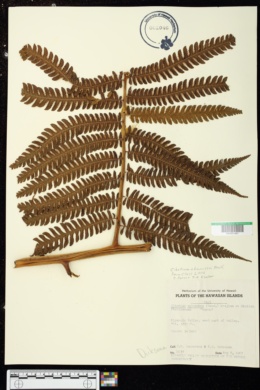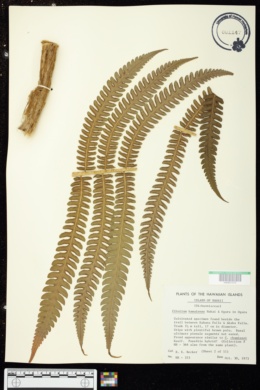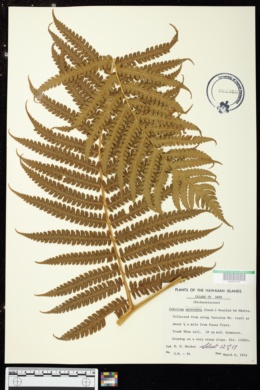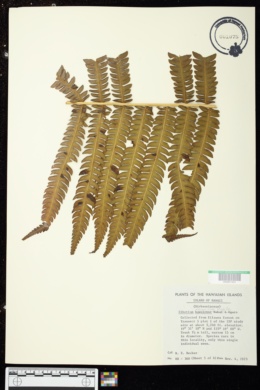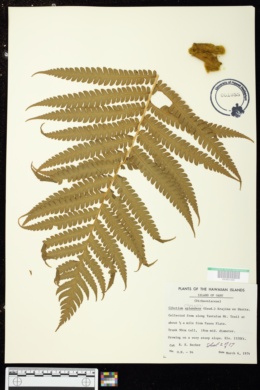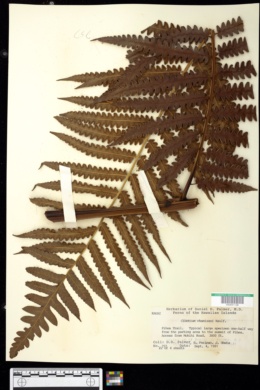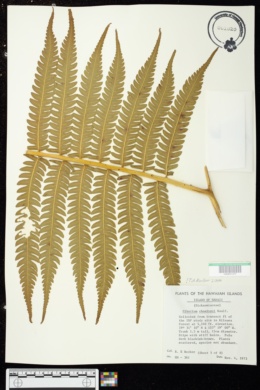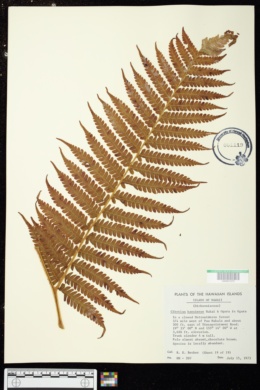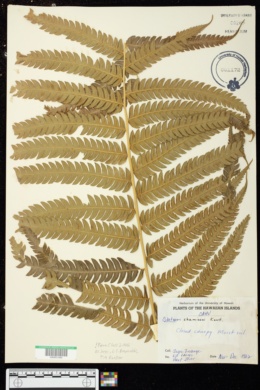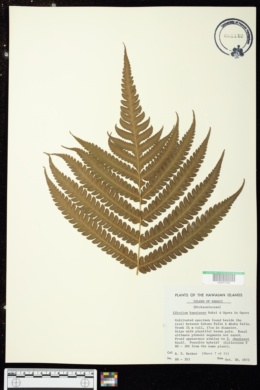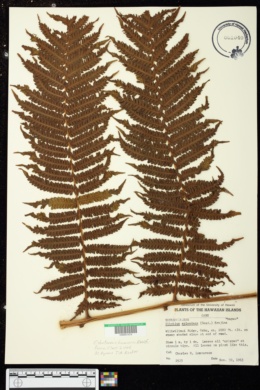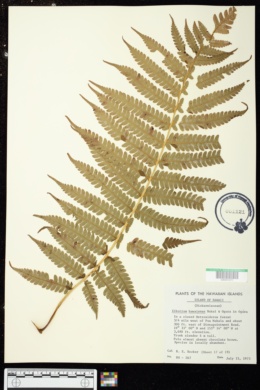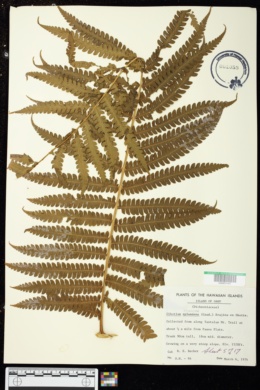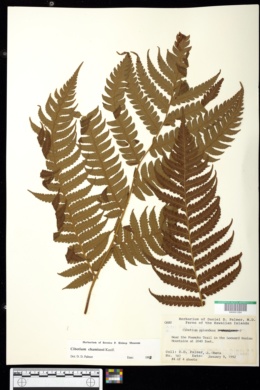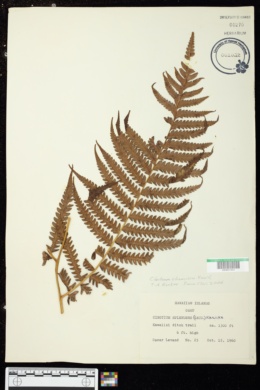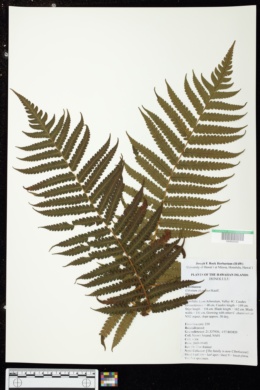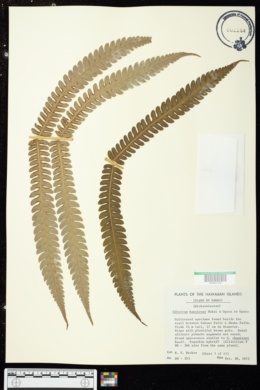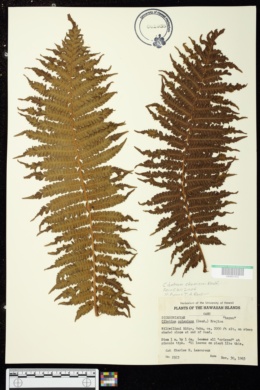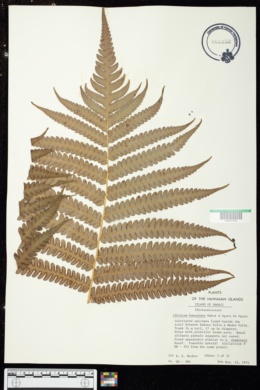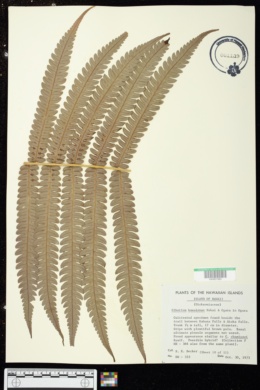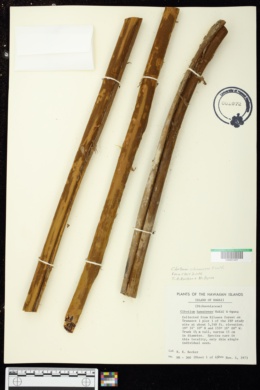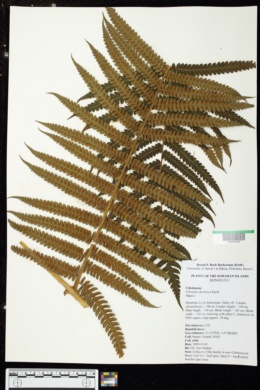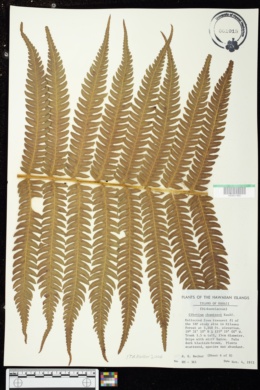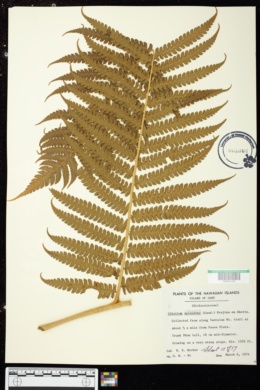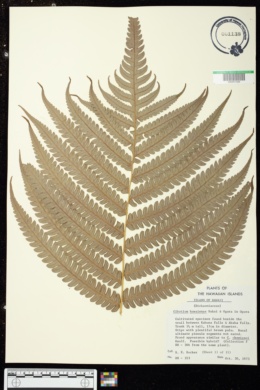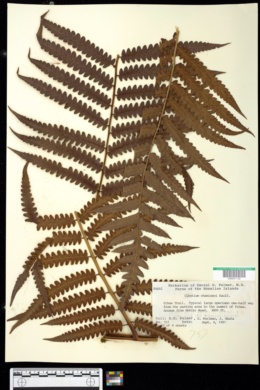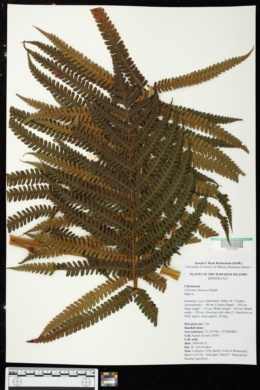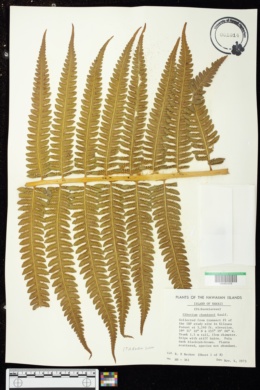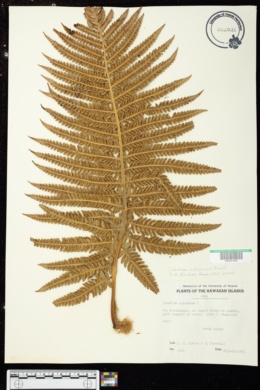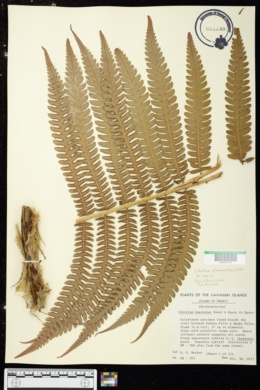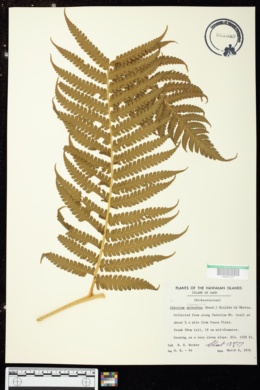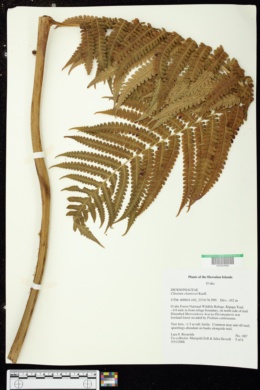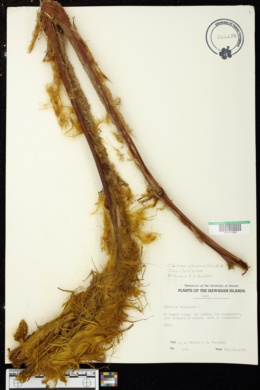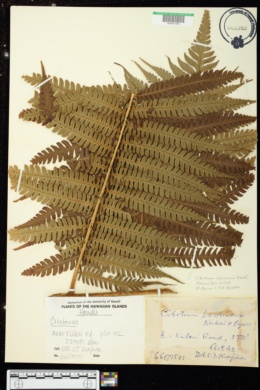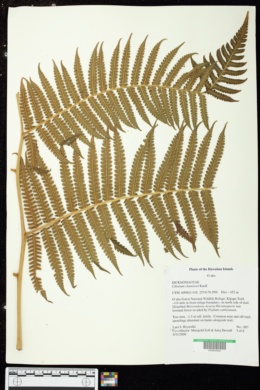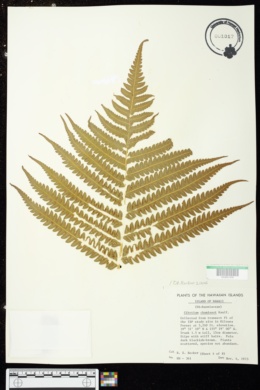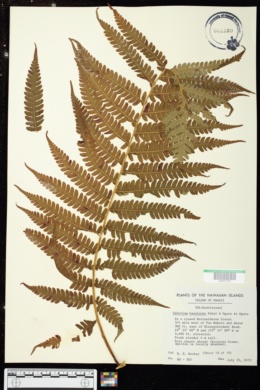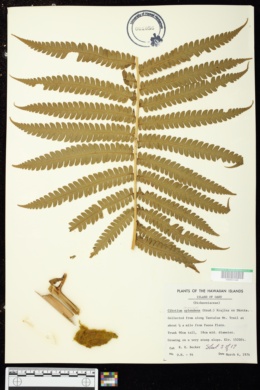
|
|
|
|
Family: Dicksoniaceae
Chamisso's manfern
[Cibotium hawaiense Nakai & Ogura, moreCibotium hawaiiense Nakai & Ogura, Cibotium splendens (Gaudich.) Krajina ex Skottsb.] |
Cibotium hawaiense Nakai & Ogura; C. nienziesii sensu Skottsb., non Hook.; C. splendens (Gaudich.) Krajina ex Skottsb.; Dicksonia splendens (Gaudich.) Desv.; Pinonia sp/endens Gaudich. Common names: hapu 'u Endemic Specific name honors Ludolf Karl Adal-bert von Chamisso ( 1781-1838), French-born German explorer, naturalist, author, and poet, who collected plants for the Russian Kotzebue expedition, from which Kaulfuss named more than twenty new species of Hawaiian ferns. Caudices 1-2(-6) m tall, 10-16 cm diam., old fronds retained as a "skirt." Fronds to 5 m long. Stipes glabrous except at base covered with a wooly mass of golden or mustard-colored hairs, young stipes with evanescent tan scurf. Pinnae sinuses narrow-angled, cut 7/8 or more to costa. Ultimate segments narrow and oblong, 4-5 mm wide, occa-sionally with a rounded enlargement at bases of basiscopic basal segments, abaxial sur-face dull light green, slightly glaucous, clothed with heavy or sparse covering of long, tan, arachnoid, soon-falling hairs (often absent on older fronds or older her-barium sheets), adaxial surfaces darker green, tips obtuse. In mesic to wet forests, 150-1,200 m, occa-sionally as low as 50 m, less common above 800 m, all major islands except Kaua 'i. Cibotium chamissoi is common on O'ahu and is uncommon and scattered on Moloka'i, Maui, Lana'i, and Hawai'i. It is invariably the first Cibotium species seen when ascending ridges on O'ahu, and after some distance it is joined by C. menziesii, with which it occasionally hybridizes. There is usually then a gap in which tree ferns are sparse or absent, followed by the dominance of C. glaucum at higher elevations. Cibotium chamissoi may be easily iden-tified m the field by its stipes that are naked except for golden or mustard-colored hairs near their base; a retained "skirt" of dead fronds; light green blade undersurfaces clothed with tan, cobwebby hairs; and narrow ultimate segments lacking pointed auricles ("ears") and with narrow, deeply cut sinuses between them. Large treeferns are among the most distinctive and most beautiful plants of Hawaii's tropical rain forests. They are easily identified as ferns by their giant feathery or lacelike fern leaves (fronds) unrolling from a densely hairy coil and by the absence of flowers, fruits, and seeds. The unbranched trunks, leafy only at the top and evergreen, qualify as trees. Six species of treeferns, all belonging to the genus Cibotium, have been distinguished as native in Hawaii. All have their powdery beadlike masses (sori) of microscopic spores in yellowish boxlike cups (indusia) in 2 rows on edges of under surface of leaf segments. Smaller trunked ferns, genus Sadleria with 6 or fewer native species, are treelike and have been included with an example, species No. 4, 'ama'uma'u, Sadleria cyatheoides. These smaller ferns bear their spores along midvein between 2 long black folds or lines. This species, the native treefern of largest size, is recognized by the rough leafstalks covered with long stiff, shaggy blackish hairs and by the broad thickened leaf segments with prominent veins often branching. A small tree with trunk usually less than 10 ft (3 m) high, rarely to 23 ft (7 m), and with several very large erect spreading leaves adding as much as 10 ft (3 m). The unbranched trunks are covered in lower part with compact masses of fibrous blackish air roots as much as 2-3 ft (0.6-0.9 m) in diameter, usually much smaller. Leaves (fronds) several, erect and spreading, the oldest dying and bending down along trunk, very large, feathery, divided 3 times (pinnate), mostly 6-12 ft (1.8-3.7 m) long and 3-5 ft (0.9-1.5 m) wide. Leafstalk or axis (stipe) to 3 ft (0.9 m) long, stout, green, rough, and warty, the enlarged base shaggy with long glossy reddish brown narrow flattened hairlike scales, beyond with coarse, long stiff black hairs or bristles often shaggy and forming dense cover. The main axis is rough and bears many pairs of branches (pinnae) to 21/2 ft (0.8 m) long, further divided. Branches (pinnules) many pairs, narrowly lance-shaped, 5-10 in (13-25 cm) long and 1-1 1/2 in (2.5-4 cm) wide, ending in very long narrow point, with very short stalk at base, divided or lobed 3/4 to midvein. Segments or lobes many, nearly paired, oblong rounded, to 1/2 in (13 mm) long and 1/4 in (6 mm) wide, with edges turned under, slightly thickened, upper surface green and hairless with prominent veins often forked, lower surface paler and usually hairless. Cibotium chamissoi Kaulf. Older leaf segments bear, on lower surface at ends of veins and on edges, 2 rows of 7 or fewer yellowish boxlike cups (indusia), each containing masses of dark brown spore cases (sporangia), which shed masses of microscopic spores abundantly. These boxlike cups are 1/16 in (1.5 mm) wide, larger than in related species. In cross section the trunk has a thick outer mass of compacted fibrous blackish air roots, next the small stem with hard outer wall. Within is the whitish soft pith containing scattered woody strands or leaf traces. Trunks of ferns are not divided into bark and wood and increase in diameter only slightly. Fortunately, these treeferns are hardy. They withstand damage by cattle and when uprooted by wild hogs continue to grow, so long as the growing tip or "fiddlehead" is not destroyed. A felled trunk can form many shoots. However, a few treeferns may be killed by shading of larger trees. Young plants of species No. 116, 'ohi'a lehua, Metrosideros polymorpha, often begin growth from seeds that lodge and germinate among the moist leaf bases and air roots in the top of a treefern. Then roots are sent to the ground. Thus, some Hawaiians believed that the treefern was the parent. This species is common and widespread in wet forests at low and middle altitudes of 800-6,000 ft (244-1,829 m) through the 6 large islands. It is a characteristic understory plant in 'ohi'a forests and with other treeferns often forms dense undergrowth. The largest treeferns and best displays are on the Island of Hawaii, such as in the forests of Puna, Hilo, and Kohala Mountains |


